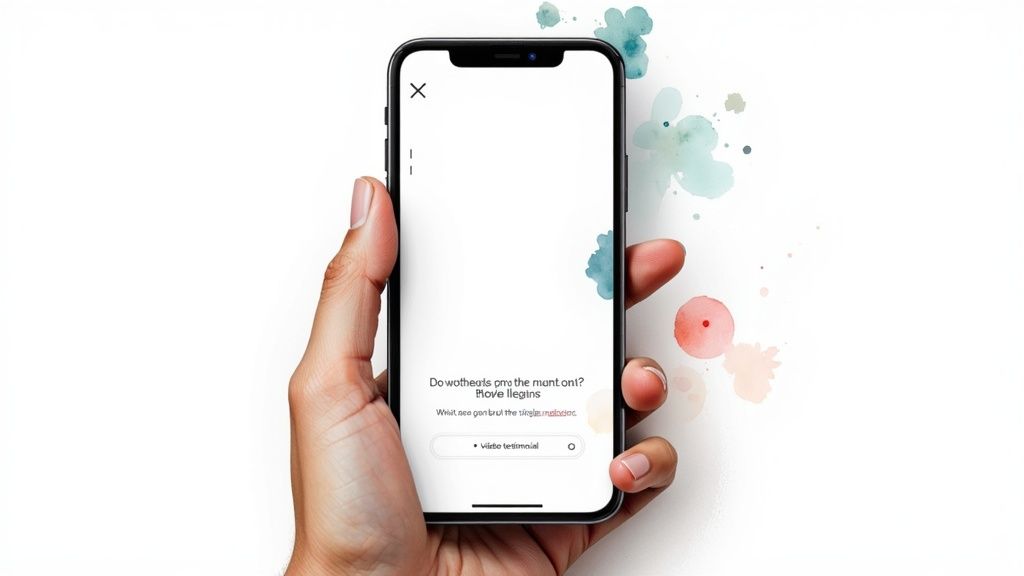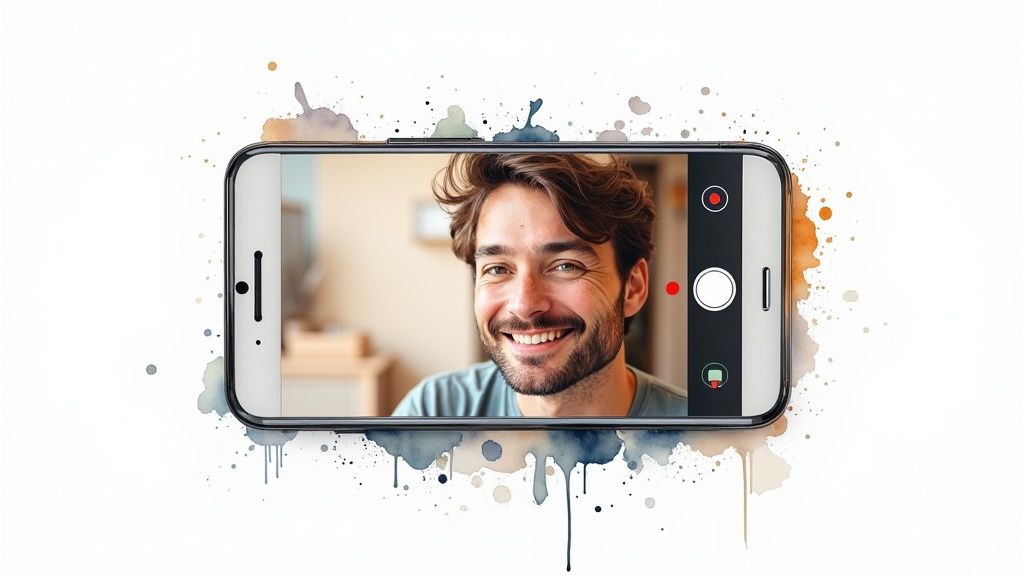Your Client Testimonial Form Sucks. Let's Fix It.
Stop getting useless praise. Learn how to build a client testimonial form that extracts powerful social proof you can use to grow your business.
Posted by
Related reading
Customer Advisory Board: The Founder's Playbook for Avoiding Catastrophic Mistakes
A practical guide to building a customer advisory board that provides honest insights, validates your strategy, and prevents costly product mistakes.
Reputation Management Tools: The Secret Weapon Behind Loyal Customers & Higher Revenue
Reputation management tools help you track customer opinions, detect red flags early, and convert negative feedback into retention wins. See how they work & why feedback-driven SaaS like Backsy outperforms survey-only tools.
How to Collect Anonymous User Feedback (With Ready-to-Use Form Example)
Learn how to collect anonymous user feedback with higher honesty and lower bias. Includes examples, templates, and a ready-to-use feedback form you can embed instantly.
Your client testimonial form isn't a suggestion box. It's a weapon. But right now, you’re using it like a squirt gun. You ask polite questions and get polite, useless answers. “Great service!” doesn’t close deals. It doesn’t crush objections. It’s vanity filler, and it’s costing you money.
We're not here to collect compliments. We're here to extract the raw, unfiltered proof that convinces skeptical prospects to buy.
Why Your Testimonials Are a Waste of Pixels
Let’s be brutally honest. Your current testimonial form is a joke. It asks, "How was your experience?" and you get garbage back. You’re celebrating five-star ratings that convince no one because they have no soul. No pain. No transformation.
Ignore your customers, and you’ll be lucky to survive the quarter. Prospects land on your site armed with skepticism, and your fluffy quotes are like bringing a knife to a gunfight. They need to see their own struggle in your customers' words. The numbers are clear: authentic testimonials can boost sales by 270%. This isn't marketing fluff; it's a growth engine. You can read the stats yourself on WiserReview.com.
Your form needs to be a scalpel, not a sledgehammer. It must dissect the journey from "before" (hell) to "after" (victory). Anything less is just noise, and noise doesn't pay the bills. If you don't even know how to create feedback forms that work, you're already behind.
Takeaway: Stop asking for compliments and start hunting for conviction.
The Only 5 Questions That Matter
Your 20-question survey is getting ignored. Even if it’s not, you're getting watered-down answers that are useless for marketing. Get surgical. A proper client testimonial form extracts a "before-and-after" story. That’s what sells.
Most forms are built for vanity, not for war. They collect compliments instead of the proof you need to arm your sales team.
The Story Arc That Closes Deals
Your entire form must be engineered to pull out this five-part narrative. Each question is a tool. Everything else is a distraction.
- The Pain: "Before you found us, what was the single biggest challenge you were struggling with?" This uncovers the hell your prospect is currently in. You want raw, emotional language, not corporate jargon.
- The Failed Attempts: "What other solutions did you try that just didn't work, and why not?" This positions you against the competition by highlighting their failures. It's a tactical masterpiece.
- The Discovery: "What was the 'aha' moment when you realized our solution was the right one?" This is the turning point. It's the hook for a case study.
- The Victory: "What specific, measurable result have you seen since working with us?" Forget feelings. We need numbers, percentages, dollar signs. This is undeniable proof.
- The Referral: "If you were to recommend us, who is the perfect type of person you'd suggest we talk to?" This forces them to articulate your ideal customer profile in their own words. Pure gold.
This five-question structure gives you a genuine business asset, not just a pat on the back. For more on this, read our guide on the most effective questions on feedback forms.
Question Framework: From Useless to Unbeatable
Look at the difference. This is where the magic happens.
| The Weak Question (What You're Asking Now) | The Killer Question (What You Should Ask) | Why It Works |
|---|---|---|
| How satisfied are you with our service? | Before you found us, what was the single biggest challenge you were struggling with? | Focuses on a relatable problem and taps into emotion. |
| Did you consider any alternatives? | What other solutions did you try that just didn't work, and why not? | Highlights your value by contrasting it with competitor failures. |
| What's your favorite feature? | What specific, measurable result have you seen since working with us? | Swaps vague opinions for hard data (ROI, time saved). |
| Would you recommend us? | If you were to recommend us, who is the perfect type of person you'd suggest we talk to? | Turns a simple "yes" into a detailed customer profile. |
Takeaway: Stop asking what people think. Start asking what they did.
Design a Form That Doesn't Suck
Great questions are useless if your client testimonial form is a clunky mess. Your design is either an ally or a roadblock. Stop sending naked links. It’s lazy. Embed the form on a dedicated 'thank you' page after a purchase or milestone. Catch them at peak happiness, don't ambush them three weeks later.

Keep It Brutally Simple
Your form needs to feel less like a tax audit and more like a quick chat. Use a 'one question per screen' layout. It transforms an interrogation into a conversation. No one wants to face a wall of 10 empty text boxes.
Non-negotiable design elements:
- Show a progress bar: Let people see the finish line. It’s a cheap psychological trick that works.
- Prime for video: Don’t ask for a video upfront. It's a huge ask. Add a checkbox at the end: "Would you be open to recording a 30-second video version of this?" Plant the seed, don't force the harvest.
- Automate with success signals: Trigger the form when a user hits a milestone, raves in a support ticket, or renews. Hunt for happy moments.
Your form's design reflects how much you value your customer's time. Over 50% of customers will ditch you after one bad experience—even a bad form. Check the customer experience stats from Zendesk if you don't believe me. This stuff matters. If you're still lost, review our guide on how to create a questionnaire.
Takeaway: A cheap-looking form gets you cheap, useless answers.
The Unfair Advantage of Video
Written testimonials are fine. Video is in another league. Seeing a face and hearing emotion builds instant trust. If you’re not asking for video, you’re leaving money on the table. This isn't about producing a Super Bowl commercial; it's about capturing raw conviction.

Making the Ask Painless
The moment a glowing written response hits your inbox, act. Send a personal email: “Wow, this is fantastic! Thank you. Would you be open to hopping on a 5-minute call to record this as a short video? My team will handle all the editing.”
Make it dead simple. Offer a gift card. A shaky iPhone video from a happy customer is 1,000x more persuasive than a polished ad everyone ignores. Explore strategies for viral video marketing to get these stories seen. Your competitors are too lazy to do this.
The numbers are insane. 72% of marketers see a 50%-500% ROI from testimonial videos. 88% of enterprise companies see a conversion lift of at least 10%. See the data from Influence Marketing Hub.
Takeaway: A raw video testimonial is one of the most powerful sales assets you can own. Start asking for them yesterday.
How to Use Testimonials Without Looking Desperate
You collected killer quotes. Now what? Don't ghettoize them on a "Testimonials" page nobody visits. That page is a graveyard for your best sales material.
Think of testimonials as surgical strikes. Deploy them strategically.
- Homepage: A powerful one-liner right under the headline to build instant trust.
- Features Page: A relevant quote right next to the benefit it praises.
- Pricing Page: A quote about ROI to dismantle cost objections before they form.
Context is Your Secret Weapon
A quote from "John S." is worthless. Put a face to the name. Add a headshot, job title, and company logo. Suddenly, it's a credible endorsement.
- Build case studies: Expand your best testimonial into a full story: problem, solution, results.
- Repurpose for social: Chop video testimonials into 15-second clips. They’ll crush your polished ads.
- Arm your sales team: Create a library of testimonials sorted by objection. Let your reps drop them into emails to close deals.
Your client testimonial form captures proof. Understanding the principles of professionalism and client satisfaction shows why this works.
Takeaway: Don't stack testimonials like firewood. Deploy them at the exact moment a prospect feels doubt.
Stop Guessing and Start Asking
So, what's it going to be? A generic form that brings in flimsy quotes? Or a system that pulls the exact words you need to close more deals?
Most founders are too lazy to do this. They’d rather guess what customers think than have one honest conversation. Here's the hard truth: ignore your customers, and you’ll be lucky to survive the quarter. Listen to them—really listen—and you can build something that lasts.
Your client testimonial form isn't a chore. It's how you figure out what actually sells.
Takeaway: Stop guessing. Ask the right questions and let your best customers do the selling for you.
Frequently Asked Questions
Alright, let's cut through the usual nonsense. Here are straight answers to the questions that trip people up.
What if I Get Negative Feedback?
Good. Negative feedback is gold. It’s a free, unfiltered look at where you're failing. Hiding from it is cowardice. When a bad review comes in, call that person immediately. Understand their frustration and own your mistakes. I’ve turned my most pissed-off early customers into my biggest champions just by handling their complaints with respect and action.
Takeaway: Don't fear criticism. It’s a roadmap. How you handle it turns haters into fans.
How Often Should I Ask for Testimonials?
Wrong question. Ask when, not how often. Sending a request 90 days after purchase is lazy. You need to pinpoint "peak happiness."
- Did a user just hit a key milestone?
- Did they upgrade their plan unprompted?
- Did they send a rave review to support?
That's when you ask. Use behavior as your trigger, not a calendar.
What's the Best Tool to Use?
Stop overthinking the tool. The questions matter more than the software. A simple Google Form works fine to start. Typeform is better for a conversational feel.
When you're serious about building a testimonial engine, especially with video, you’ll need a dedicated platform. This should be a core growth strategy, not a side project.
Stop building forms that collect dust and start building a machine that closes deals. Grab a Backsy form and turn your happiest clients into your best damn sales team. https://backsy.ai